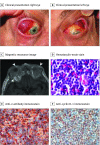Clinicopathological Features of Ocular Adnexal Mantle-Cell Lymphoma in an International Multicenter Cohort
- PMID: 29121219
- PMCID: PMC6583534
- DOI: 10.1001/jamaophthalmol.2017.4810
Clinicopathological Features of Ocular Adnexal Mantle-Cell Lymphoma in an International Multicenter Cohort
Abstract
Importance: To our knowledge, the clinical features of ocular adnexal mantle-cell lymphoma (OA-MCL) have not previously been evaluated in a large multicenter cohort.
Objective: To characterize the clinical features of OA-MCL.
Design, setting, and participants: This retrospective multicenter study included patient data collected from January 1, 1980, through December 31, 2015, at 6 eye cancer centers in 4 countries. Medical records of 55 patients with OA-MCL were reviewed; the median length of follow-up was 33 months.
Main outcomes and measures: Overall survival, disease-specific survival, and progression-free survival were the primary end points.
Results: Fifty-five patients were included; ocular adnexal MCL was found to be most common in older individuals (mean age, 70 years) and men (n = 42 of 55; 76%). Patients with OA-MCL frequently presented with disseminated lymphoma (n = 34 of 55; 62%), and were likely to experience stage IVE disease (n = 35 of 55; 64%), with bilateral involvement (n = 27 of 55; 47%), tumor masses (n = 27 of 36; 75%), and involvement of the orbit (n = 32 of 55; 58%). Chemotherapy with or without external beam radiation therapy was the most frequently used treatment. Overall survival rates for the entire cohort were 65% at 3 years (95% CI, 52%-78%) and 34% at 5 years (95% CI, 21%-47%). Disease-specific survival after 5 years was 38% for the entire cohort (95% CI, 25%-51%); the disease-specific survival adjusted by eye cancer center was better in patients who had received rituximab in addition to the chemotherapy regimen (hazard ratio, 3.3; 95% CI, 1.0-14.7; P = .06). The median progression-free survival was 2.3 years (95% CI, 1.8-2.7 years) in patients who experienced recurrence after primary treatment, and 4.1 years (95% CI, 3.9-4.3 years) in patients who presented with a relapse of systemic lymphoma in the ocular adnexal region.
Conclusions and relevance: These results suggest that the distinctive features of OA-MCL are its appearance in older male individuals, advanced stage and bilateral manifestation at the time of diagnosis, and aggressive course. The prognosis of patients with OA-MCL might be improved by addition of rituximab to chemotherapy treatment.
Conflict of interest statement
Figures


Comment in
-
Mantle-Cell Lymphoma-Taming the Tiger.JAMA Ophthalmol. 2017 Dec 1;135(12):1374-1375. doi: 10.1001/jamaophthalmol.2017.4290. JAMA Ophthalmol. 2017. PMID: 29121204 No abstract available.
References
-
- Rasmussen PK. Diffuse large B-cell lymphoma and mantle cell lymphoma of the ocular adnexal region, and lymphoma of the lacrimal gland: an investigation of clinical and histopathological features. Acta Ophthalmologica. 2013;91 (thesis 5):1-27. - PubMed
-
- Dreyling M, Geisler C, Hermine O, et al. ; ESMO Guidelines Working Group . Newly diagnosed and relapsed mantle cell lymphoma: ESMO Clinical Practice Guidelines for diagnosis, treatment and follow-up. Ann Oncol. 2014;25(suppl 3):iii83-iii92. - PubMed
-
- Oka K, Ohno T, Yamaguchi M, et al. . PRAD1/Cyclin D1 gene overexpression in mantle cell lymphoma. Leuk Lymphoma. 1996;21(1-2):37-42. - PubMed
-
- Vaandrager JW, Schuuring E, Zwikstra E, et al. . Direct visualization of dispersed 11q13 chromosomal translocations in mantle cell lymphoma by multicolor DNA fiber fluorescence in situ hybridization. Blood. 1996;88(4):1177-1182. - PubMed
-
- Andersen NS, Jensen MK, de Nully Brown P, Geisler CH. A Danish population-based analysis of 105 mantle cell lymphoma patients: incidences, clinical features, response, survival and prognostic factors. Eur J Cancer. 2002;38(3):401-408. - PubMed
Publication types
MeSH terms
LinkOut - more resources
Full Text Sources
Other Literature Sources
Medical

